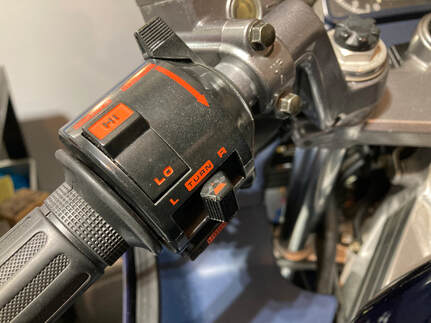
The signals all share common electrical components, so if one side are working and the other not, then items like the flasher and fuse are not the problem. I find that an issue like this is often in the handlebar switch assembly; likely just dirty contacts. That proved to be the case here.
When I split the switch case (below, left) I can see that the old grease is gummy and dirty. This is a simple mechanical device — moving the pivoting switch lever left or right moves the opposite end left or right. When we remove that lever assembly (below, right) we see that that lever is actually moving the white-colored sliding plastic block right or left (yellow arrows). That movement makes electrical contact on the face of the black-colored plastic block (pink arrow) which directs the electrical current to the right or left turn signal circuits. When centered, as in the photo, no electrical contact is made. Our problem is that the contacts, which are exposed to dirt and humidity, are no longer making positive contact.
The solution is to spray the contact area with electrical contact cleaner and then coat with a bit of dielectric grease. I also give the switch lever a similar treatment, which makes the switch action smooth and crisp, just like when new. Carefully reassemble the components with their tiny screws, check that the choke cable is in good condition and button everything back up. NOTE: This task is completed with the switch left in place on the handlebar.


 RSS Feed
RSS Feed